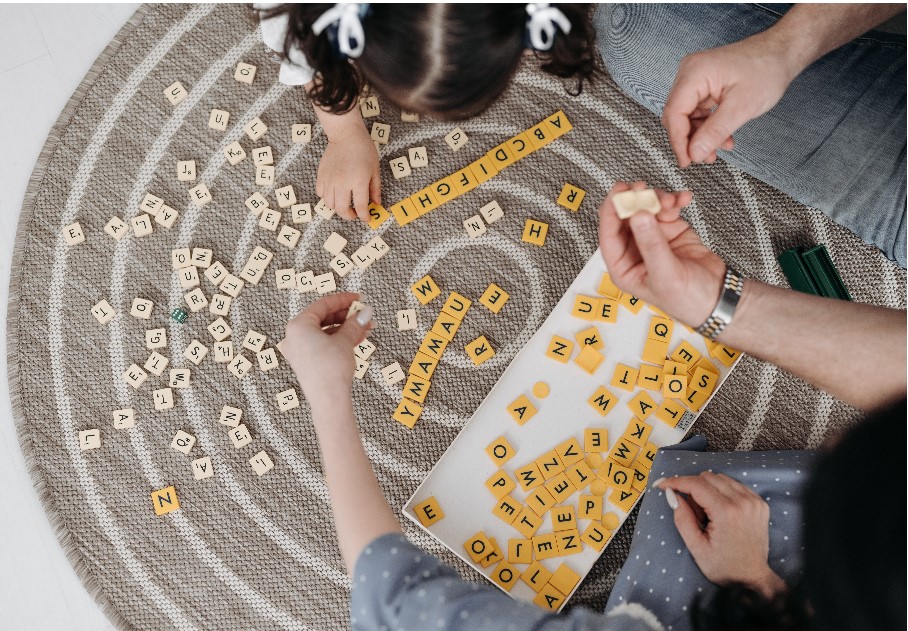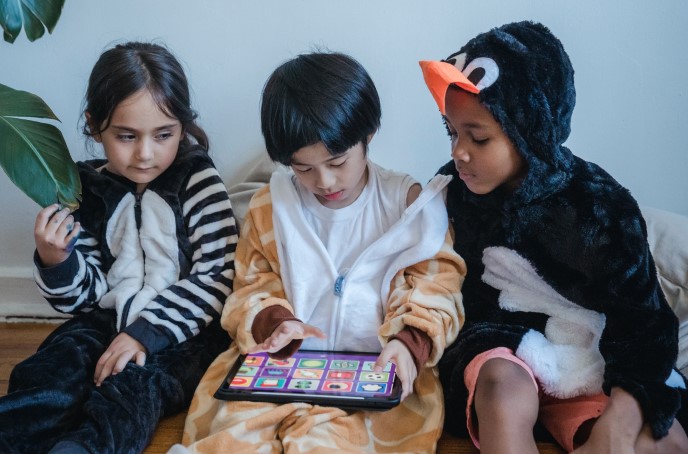Children are naturals at learning a new language.
Language is a tool we use to communicate with other people, so interaction and learning that is fun and engaging while communicating with others is great for kids. Sharing this journey with your children is more meaningful. It’s also more effective and they’ll retain more than learning by themselves from online courses or workbooks.
There are some excellent technology-related resources to reinforce learning, however, so I’ll include a couple of these at the end of my list. Here are 10 ways to provide an environment that encourages English language learning:
1. Read to them or have them read books in English out loud. To begin, choose books that are already their favorites in their native language. Reading out loud, although it may be stilted and difficult at first, helps to develop a familiarity with the language even before they acquire comprehension and can also help add correct expression to their speaking.


2. Play games with them in English. There are a variety of games which bolster their vocabulary and increase grammar knowledge. Keeping learning fun and not a chore is a great way to keep children, especially younger children engaged in the learning process. For a list of some awesome games to try, check out my blog on gifts that help kids learn English (here).
3. Give gifts that challenge them and increase their knowledge. Including a gift for birthdays or holidays that emphasizes learning English in a fun way communicates to your children that you believe in the importance of mastering the language as well as gives them fun ways to keep learning.

4. Introduce a new puppet or stuffed animal that only speaks English. Children love interacting with their favorite toys in this way, so introducing one that is also learning English is fun and entertaining for your kids, and also gives them the opportunity to help the toy learn. Teaching is a great way to reinforce learning. Having your child help his or her favorite toy learn gives them an opportunity to share what they’ve learned.
5. Hire a caregiver that speaks English. For more challenge (and faster learning) make it a rule that he or she only speaks in English. Even if the caregiver only comes over once or twice a week, your children will still gain important language skills by communicating in English with their caregiver.
6. Organize playdates with friends who speak English. Children are great imitators of language, and also learn incredibly fast when placed in an immersive language environment. The social pressure to communicate and fit in with their friends during play will encourage them to use their developing English language skills more.
7. Watch tv or movies in English. Just as for reading, start with shows they are already familiar with. Initially watch with subtitles in their native language, then switch to English subtitles. Another great technique is to delay the subtitles, giving your children the chance to hear what is said and begin translating themselves before reading the translation.
8. Learn English with your kids! This is a fantastic way to share something with them. As parents, too often we watch our kids grow older and away from us, so learning a new language that can be a special new way to communicate can build bonds and enhance learning.


9. Find ways to use English in ways that feel natural rather than making it a requirement. Creating a rule for when English is used, such as speaking English at the dinner table, can increase stress for your child and maybe even make them resistant to even trying. Instead, incorporate English into everyday things like chores or tasks where what you are saying can be easily understood by the actions that accompany it. Try describing what you or they are doing in English, or give each other simple tasks to do, or give walking or driving directions in English. This can be included in play time as well, using English to describe what your child’s toys are doing. The key is to creatively include English into your day-to-day activities without making your child feel pressure to perform.
10. Emphasize communication over perfection. Unless you’re doing a worksheet or activity that teaches a grammar concept, focus on how well your child communicates in English. Language is communication above all else, so concentrate on increasing vocabulary over grammar. Also, allowing a mix of English with your child’s native language is okay too.

And some technology-related ideas to round out my list:
Set the speech on your child’s electronics to only speak in English. Games, mobile phones, computers, and home virtual assistant technology, like Amazon Alexa, all can be set to speak in English.
Look into online interactive games and worksheets to encourage and reinforce learning. Some examples are Duolingo. Online or with a mobile app, Duolingo claims to be the “free, fun, and effective way to learn a language”. Using research-based AI, Duolingo makes language learning easy and fun. Another app that is good for older students is Grammar Up. Grammar Up has more than 1800 questions on grammar topics. It’s great for testing your grammar knowledge or for preparing for tests. It also provides feedback at the end of each test which shows what you missed. It keeps track of your results over time too, giving you important feedback on areas that you need to concentrate on.


Also, try the free worksheets from Kids Academy. Developed for children from Pre-Kindergarten through 3rd Grade, these worksheets and games are fun activities that encourage language learning. Kids Academy also has an app with over 5,000+ educational games, videos, and printable worksheets.
Your local library may have access to an online English learning program called Mango Language. To get access to it, all you need is a library card. Check with your local library to see if they participate in this program.
Lastly, don’t forget to consider a private tutor to help your child learn to speak English. For more information on classes that we offer, click here.



1 comment
Comments are closed.